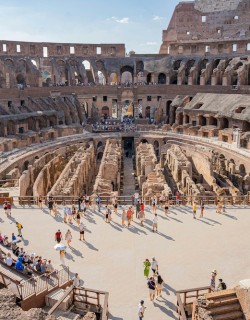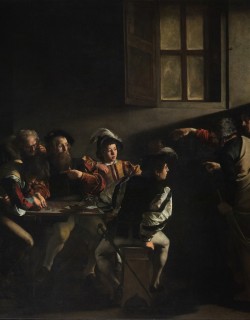Everyone who visits Rome comes to admire the Colosseum, often on a Rome walking tour, but lots of visitors are unaware of the bustling neighborhood on the nearby hill. There are churches next to cocktail bars, art galleries, and vintage clothes shops. At lunchtime, bankers and music students queue up for a delicious piadina. Carpenters are hard at work in the workshops while fashion-conscious young Romans browse the boutiques or drink beer on the steps of the fountain in the historic piazza.
This is Monti, one of the trendiest and most lively neighborhoods in Rome. It’s an ancient part of the city that has recently been undergoing some kind of gentrification, but without losing any of the character that makes it so popular with visitors and locals alike.
If you’re at the Colosseum, just take a five-minute walk to the northwest, or if you’re on the metro, get off at Cavour (B line) and start to explore the streets around you. You don’t have to go far to get some idea of Monti’s unique character and history. One of the metro exits is in Piazza della Suburra, where you can find traditional restaurants but also a cool new cocktail bar, Suburra 1930, and the ever-popular Mercato Monti, a market selling quirky jewelry, vintage sunglasses, and clothes by up-and-coming young designers.
Standing in Piazza della Suburra, Monti’s modern appeal is easy to understand, but for the history, we have to dig a little deeper. Many modern locals are oblivious to this neighborhood’s dark past. In ancient Rome, it was anything but gentrified – it was notorious as a lower-class slum and red-light district. Locals would have lived in insulae (apartment blocks) which were six or seven storeys high, and the poorest inhabitants lived in dismal conditions on the top floors, without heating or running water.
As you watch stylish young Italians meeting each other outside the metro station on a Saturday night, try to imagine the piazza in ancient times – prostitutes looking for business in pitch-dark streets (there were no street lights in ancient Rome) and the unlucky inhabitants of the sixth floor throwing their excrement out of the window. Many modern visitors wish they had a time machine so they could explore ancient Rome, but perhaps some aspects of the ancient city are better left to the imagination.
Even though Julius Caesar was born into an aristocratic family, he was also born in one of the roughest parts of the city – the Suburra. One historian has speculated that Caesar’s house was on the road now known as Via Cavour, in the heart of Monti. Although it’s now one of the most desirable areas to live in Rome, Caesar probably would have been ashamed of growing up in such a notorious neighborhood.
There may be no trace of Caesar’s house or the less salubrious elements of the Suburra, but there are still plenty of historical sites in Monti and the surrounding area. While most people think of Monti as the small web of streets between Via Cavour and Via Nazionale, technically, the neighborhood includes the Colosseum, the markets of Trajan, and the Domus Aurea (Nero’s pleasure palace). A climb up the hill brings you to the church of San Pietro in Vincoli (St Peter in Chains) and an often overlooked Renaissance masterpiece, Michelangelo’s magnificently bearded statue of Moses.
While many locals are elderly Romans who have lived in the neighborhood their entire lives, Monti is also a magnet for the younger generation. It’s easy to see why. It’s less crowded and touristy than Trastevere, another part of Rome with a buzzing nightlife, but there are still plenty of cool bars. The coolest is, of course, the Ice Club on Via Madonna dei Monti, but if you’re looking for somewhere hip rather than literally cold, take your pick from the bars on Via Urbana or Via Panisperna like the laidback Blackmarket, an art gallery and wine bar.
Monti is especially good if you’re looking to meet new people. Cineclub Detour, a tiny arthouse cinema on Via Urbana, hosts regular aperitivo evenings, while Finnegan’s Irish pub is friendly and relaxed. The most popular place in Monti, however, is Piazza della Monti dei Madonna, which is particularly lively in the evening. If you hang out on the steps of the fountain, you’re bound to meet someone new.
There’s something quite appealing about the contrasts and odd juxtapositions you find in Monti – the way that certain clothes shops aspire to a London level of cool while their next-door neighbors serve unpretentious pizza by the slice. Compared to other neighborhoods in Rome, Monti always seems to be changing, with new bars and shops opening all the time. However, it only takes a glimpse of a workshop or a meal at a typical trattoria like the appropriately named Vecchia Roma to realize that some things never change.
Monti residents may no longer throw their excrement into the streets or throw stones at their rivals (the residents of the nearby neighborhood Trastevere), but Monti has retained the pleasanter parts of its history. Whether you take a stroll through the quiet back streets during the day or join the throng in the piazza at night, you’re sure to fall under Monti’s spell. With its mix of ancient history and thriving nightlife, there’s nowhere else in Rome quite like it.
~by Alexandra Turney~



